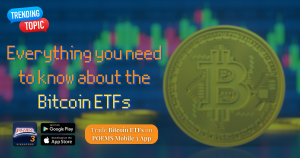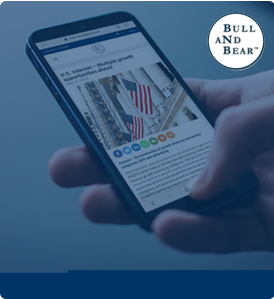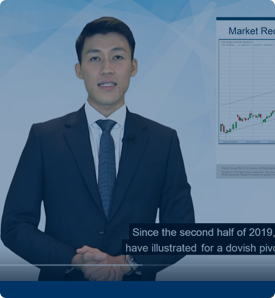Gold in the Post-COVID World April 27, 2021

Last updated on 24 September 2021
What this report is about:
- Inflation fears sparked a bond sell-off in February and March. As bond prices fell, their yields rose
- The sudden spike in interest rates and economic optimism plummeted gold prices to a 9-month low in March 2021
- However, inflationary pressures, unsustainable debt levels and monetary and fiscal policies are supportive factors for gold investment demand. The recent pullback in gold prices presents buying opportunities
- Investors can gain exposure to gold via physical gold-backed ETFs like GLD, GLDM and IAU
- Gold miners’ ETFs such as GDX and GDXJ are also highly sensitive to gold prices and provide “leveraged” exposure to gold
The Great Inflation Sell-Off
2021 has been a roller coaster ride for investors, with steep drops on one day followed by sharp rebounds on the next. Historically low interest rates and dovish monetary policies have led to a rapid expansion of global money supply and the influx of funds into the financial markets.
Consequently, the stock markets and alternative investments have surged to record highs as investors ventured into riskier asset classes to seek higher returns in the low-rates environment.
Nonetheless, the massive monetary and fiscal stimulus have also stoked inflation fears upon the gradual return to normalcy. This triggered the subsequent bond sell-off in February and March.
As bond prices fell, their respective yields rose. For example, the US 10-year Treasury yields jumped 94% in just three months; from ~0.90% in December 2020 to 1.75% by the end of March 2021.1
This episode brought the equity rally to a screeching halt, with technology stocks at the heart of the brutal equity sell-off.
What Dulled Gold’s Lustre
Besides technology stocks, gold was also routed by the rising yield. The price of the precious metal plummeted to a nine-month low of US$1,685 per ounce in March.2
Because gold does not provide intermittent cash flow in the form of coupons or dividends, the rising interest rates represent higher opportunity costs for investors.
Gold functions as a store of value and is a traditional hedge against inflation. Theoretically, investors flock to gold when they fear looming inflation. However, the climbing US Treasury yields in recent times have outpaced inflation fears and reduced the appeal of gold as an inflation hedge. The result is a drop in gold prices.
The rollout of the coronavirus vaccines and optimism of a global economic rebound further dull gold’s lustre as a safe haven asset. Henceforth, the sequence of events has caused gold prices to be stuck in a downtrend since the start of the year.
Catalysts for Gold’s Revival
Historically, gold has performed well in an inflationary environment. According to the World Gold Council, gold has an average annual return of ~15% in periods of high inflation since 1971.4
When “paper monies” are incessantly being created by the quantitative easing schemes of the various central banks, the purchasing power of fiat currencies declines.
To further aggravate the inflationary pressures, US president Joe Biden signed the latest US$1.9tn coronavirus relief package in March to send direct cash payments of up to US$1,400 to most Americans.5
A recent survey of US households suggests that most Americans plan to use over 70% of their relief packages to pay down debt and to save up for an uncertain economic environment.6 It is of no surprise that at the end of 2020, US banks held a record US$17.8tn in deposits, up significantly from US$14.5tn in 2019.7
| How US Households Intend to Use Their Stimulus Cheques | |||
| Stimulus Round | 1 | 2 | 3 |
| Reporting Month | June 2020 | January 2021 | March 2021 |
| Average Percentage Spent | 29.2 | 25.5 | 24.7 |
| Average Percentage Saved | 36.4 | 37.1 | 41.6 |
| Average Percentage For Debt Payment | 34.5 | 37.4 | 33.7 |
As the pandemic crisis eases, these massive savings will be unleashed upon the economy as people get back to their pre-pandemic lives – adding to concerns that the economy may overheat and push inflation even higher.
Gold is also widely utilised in the jewellery and technology industries. The unique dual nature of gold as a safe haven asset and consumer good has allowed it to perform well in times of systemic stress, as well as potentially benefiting from the post-COVID recovery.
Truth be told, the pandemic is far from over. New virus strains are sprouting up and nations are struggling to stem the spread of the virus. Gold’s appeal as a safe haven asset may come into play when new waves of infections strike fears among the global populace.
Furthermore, the Federal Reserve has indicated that there will be no interest rate hikes through 2023. The reiteration by the Federal Reserve has provided a supportive backdrop for gold as real yields and short-term borrowing rates are firmly anchored near zero.10
Buying Opportunity
The sudden spike in US interest rates and potential economic rebound have impeded the performance of gold in the near term. This has provided entry opportunities for investors who are considering adding gold into their portfolio mix.
Other factors such as inflationary pressures, unsustainable debt levels, liberal monetary and fiscal policies may support gold investment demand and ignite a recovery in gold prices.
Moreover, gold’s relatively low correlation with major equity indexes allows it to act as a portfolio diversifier and help lower the volatility of an investment portfolio.
Gold’s correlation with major equity indices (1 Jan 2015 to 31 Dec 2020, weekly return frequency)12
| S&P 500 | Russell 3000 | Nikkei 225 | CSI 300 | Euro Stoxx 50 | FTSE STI | |
| Gold Spot Price (US$/oz) | 0.116 | 0.106 | 0.234 | 0.034 | 0.029 | 0.229 |
How to Invest in Gold
POEMS’ Market Journal has a series of articles on the benefits, reasons and methods of investing in gold:
- A Good Time for Gold: 4 Reasons to Buy the Precious Metal
- Top 2 Reasons You Should Grab Gold Now
- Playing the Ratio Game: Gold and Silver
- 4 Reasons Why Gold Should Be Part of Your Portfolio
Investors can gain exposure to gold via Exchange Traded Funds (ETF). Physical gold-backed ETFs are convenient and cost-efficient investment vehicles, as investors do not need to incur logistics and insurance costs from holding physical gold.
Investors can easily buy and sell ETFs on exchanges and take advantage of the strategic and tactical properties of gold as a unique asset class.
| ETF | SPDR Gold Shares | SPDR Gold MiniShares | iShares Gold Trust | |||
| Ticker | GLD | O87 | GSDNew | 2840 | 1326 | GLDM | IAU |
| Exchange | NYSE | SGX | HKEx | TSE | NYSE | NYSE |
| Trading Currency | US$ | US$ | SGDNew | HK$ | ¥ | US$ | US$ |
| Assets Under Management (US$) | 57.05 billion | 4.46 billion | 28.43 billion | |||
| Expense Ratio | 0.40% | 0.18% | 0.25% | |||
| Board Lot Size | 1 | 5 | 10 | 1 | 1 | 1 |
ETF information is accurate as of 23 Sep 2021
Mining for Gold
Investors can also gain exposure to gold price movements via gold mining shares. Gold mining shares are highly sensitive to the movements of gold prices due to the underlying nature of the mining industry.
For gold miners, their production cost fluctuates much less than the price of gold. Because of this operating leverage, higher gold prices often result in increased profit margins for gold miners. As a result, an increase in gold prices can have large effects on gold miners’ valuations.
Conversely, a dip in gold prices could result in a greater downside for the gold miners.
Gold miners are also susceptible to company-specific, liquidation, political, regulatory, and environmental risk factors. Additionally, new gold deposits are increasingly costly and difficult to locate. The variations of these market forces subject gold miners to added risk factors that are typically not found in gold bullion investment.13
In short, gold mining shares are reasonably correlated to gold prices but are much more volatile. Investors often use gold mining shares as tactical instruments to obtain “leveraged” exposure to gold prices in a bid to earn excess returns.
The unsystematic risks of investing in individual gold mining companies can be drastically reduced with gold miners’ ETFs. These ETFs reduce the concentration risks by investing in a basket of gold mining companies.
| ETF | VanEck Vectors Gold Miners ETF | VanEck Vectors Junior Gold Miners ETF |
| Ticker | GDX | GDXJ |
| Exchange | NYSE | NYSE |
| AUM | US$12.9bn | US$4.3bn |
| Expense Ratio | 0.52% | 0.53% |
| Number of Holdings | 55 | 100 |
| Top 3 Holdings |
|
|
ETF information is accurate as of 12 April 2021
Reference:
- 1https://www.cnbc.com/quotes/US10Y
- 2https://www.bullionvault.com/gold-price-chart.do
- 4https://www.gold.org/goldhub/research/gold-market-commentary-march-2021
- 5https://www.cnbc.com/2021/03/11/biden-1point9-trillion-covid-relief-package-thursday-afternoon.html
- 6https://www.ft.com/content/bdc11f35-ecac-47e7-a94f-cbf3ecf080b5
- 7https://www.nasdaq.com/articles/gold-still-attractive-as-the-bond-selloff-looks-overdone-2021-03-06
- [7]https://www.lta.gov.sg/content/ltagov/en/industry_innovations/technologies/electric_vehicles.html
- 10https://www.cnbc.com/2021/03/17/fed-decision-march-2021-fed-sees-stronger-economy-higher-inflation-but-no-rate-hikes.html
- 12https://www.gold.org/goldhub/data/gold-and-major-index-correlations
- 13https://www.bullionvault.com/gold-guide/gold-mining
Disclaimer
These commentaries are intended for general circulation. It does not have regard to the specific investment objectives, financial situation and particular needs of any person who may receive this document. Accordingly, no warranty whatsoever is given and no liability whatsoever is accepted for any loss arising whether directly or indirectly as a result of any person acting based on this information. Opinions expressed in these commentaries are subject to change without notice. Investments are subject to investment risks including the possible loss of the principal amount invested. The value of the units and the income from them may fall as well as rise. Past performance figures as well as any projection or forecast used in these commentaries are not necessarily indicative of future or likely performance. Phillip Securities Pte Ltd (PSPL), its directors, connected persons or employees may from time to time have an interest in the financial instruments mentioned in these commentaries. Investors may wish to seek advice from a financial adviser before investing. In the event that investors choose not to seek advice from a financial adviser, they should consider whether the investment is suitable for them.
The information contained in these commentaries has been obtained from public sources which PSPL has no reason to believe are unreliable and any analysis, forecasts, projections, expectations and opinions (collectively the “Research”) contained in these commentaries are based on such information and are expressions of belief only. PSPL has not verified this information and no representation or warranty, express or implied, is made that such information or Research is accurate, complete or verified or should be relied upon as such. Any such information or Research contained in these commentaries are subject to change, and PSPL shall not have any responsibility to maintain the information or Research made available or to supply any corrections, updates or releases in connection therewith. In no event will PSPL be liable for any special, indirect, incidental or consequential damages which may be incurred from the use of the information or Research made available, even if it has been advised of the possibility of such damages. The companies and their employees mentioned in these commentaries cannot be held liable for any errors, inaccuracies and/or omissions howsoever caused. Any opinion or advice herein is made on a general basis and is subject to change without notice. The information provided in these commentaries may contain optimistic statements regarding future events or future financial performance of countries, markets or companies. You must make your own financial assessment of the relevance, accuracy and adequacy of the information provided in these commentaries.
Views and any strategies described in these commentaries may not be suitable for all investors. Opinions expressed herein may differ from the opinions expressed by other units of PSPL or its connected persons and associates. Any reference to or discussion of investment products or commodities in these commentaries is purely for illustrative purposes only and must not be construed as a recommendation, an offer or solicitation for the subscription, purchase or sale of the investment products or commodities mentioned.
About the author
Joel Lim
ETF Specialist
Joel is the ETF Specialist from the ETF desk in Phillip Securities. He helps to provide sales support and trading ideas to retail investors, remisiers, in-house dealers, and fund managers. Joel also works closely with ETF issuers on new product and business development projects.

 All-in-One Guide to Investing in China via ETFs
All-in-One Guide to Investing in China via ETFs  Everything you need to know on Bitcoin ETFs
Everything you need to know on Bitcoin ETFs  Maximising your Tax Savings & Retirement Funds with SRS in Singapore
Maximising your Tax Savings & Retirement Funds with SRS in Singapore  Is There a “Fairest of Them All”?
Is There a “Fairest of Them All”? 









